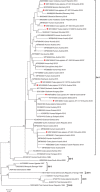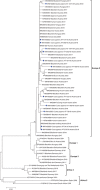Diversity of West Nile and Usutu virus strains in mosquitoes at an international airport in Austria
- PMID: 34169666
- PMCID: PMC9540796
- DOI: 10.1111/tbed.14198
Diversity of West Nile and Usutu virus strains in mosquitoes at an international airport in Austria
Abstract
Increased globalization and international transportation have resulted in the inadvertent introduction of exotic mosquitoes and new mosquito-borne diseases. International airports are among the possible points of entry for mosquitoes and their pathogens. We established a mosquito and mosquito-borne diseases monitoring programme at the largest international airport in Austria and report the results for the first two years, 2018 and 2019. This included weekly monitoring and sampling of adult mosquitoes, and screening them for the presence of viral nucleic acids by standard molecular diagnostic techniques. Additionally, we surveyed the avian community at the airport, as birds are potentially amplifying hosts. In 2018, West Nile virus (WNV) was detected in 14 pools and Usutu virus (USUV) was detected in another 14 pools of mosquitoes (minimum infection rate [MIR] of 6.8 for each virus). Of these 28 pools, 26 consisted of female Culex pipiens/torrentium, and two contained male Culex sp. mosquitoes. Cx. pipiens/torrentium mosquitoes were the most frequently captured mosquito species at the airport. The detected WNV strains belonged to five sub-clusters within the sub-lineage 2d-1, and all detected USUV strains were grouped to at least seven sub-clusters among the cluster Europe 2; all strains were previously shown to be endemic in Austria. In 2019, all mosquito pools were negative for any viral nucleic acids tested. Our study suggests that airports may serve as foci of arbovirus activity, particularly during epidemic years, and should be considered when designing mosquito control and arbovirus monitoring programmes.
Keywords: Austria; Culex pipiens; Usutu virus; West Nile virus; airport; mosquito-borne diseases; virus monitoring.
© 2021 The Authors. Transboundary and Emerging Diseases published by Wiley-VCH GmbH.
Conflict of interest statement
The authors declare no conflict of interest.
Figures




References
-
- Aberle, S. W. , Kolodziejek, J. , Jungbauer, C. , Stiasny, K. , Aberle, J. H. , Zoufaly, A. , Hourfar, M. K. , Weidner, L. , & Nowotny, N. (2018). Increase in human West Nile and Usutu virus infections, Austria, 2018. Eurosurveillance, 23(43), 1800545. 10.2807/1560-7917.ES.2018.23.43.1800545 - DOI - PMC - PubMed
-
- Anderson, J. F. , Main, A. J. , Delroux, K. , & Fikrig, E. (2008). Extrinsic incubation periods for horizontal and vertical transmission of West Nile virus by Culex pipiens pipiens (Diptera: Culicidae). Journal of Medical Entomology, 45(3), 445–451. - PubMed
MeSH terms
Substances
Supplementary concepts
LinkOut - more resources
Full Text Sources
Medical

